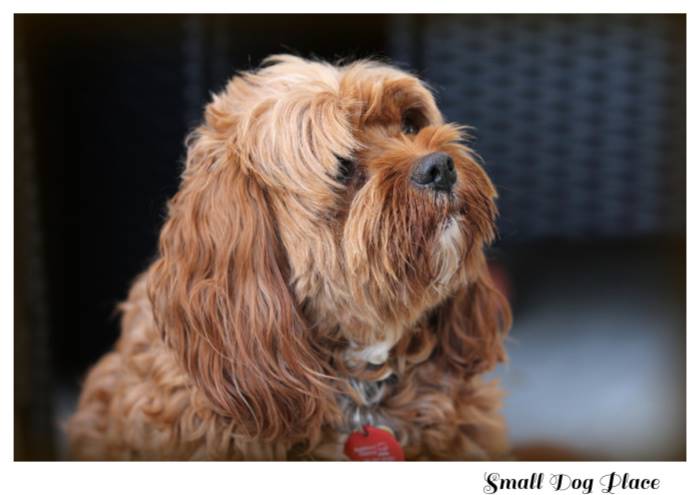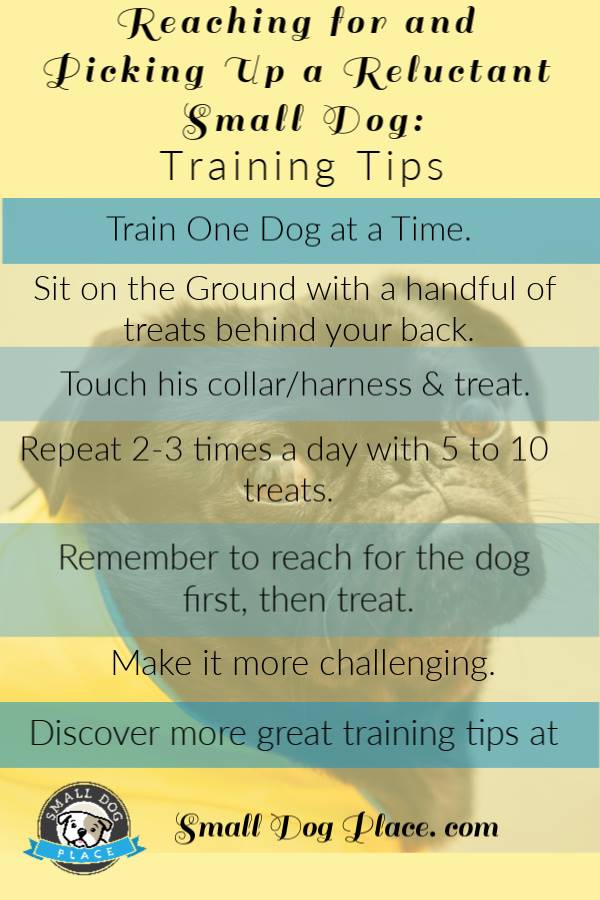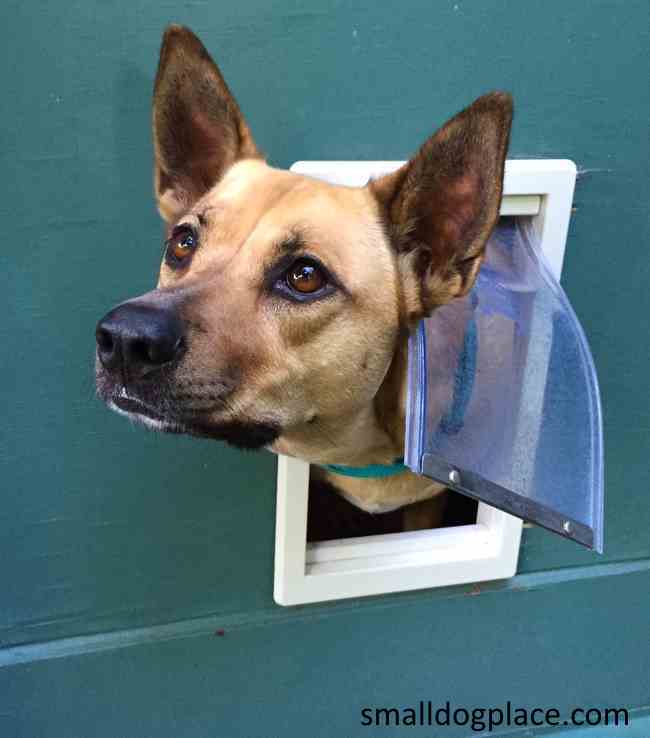- Small Dog Place Home
- Training
- Train a Small Dog Not to Run Away
How to Train a Small Dog Not to Run Away: Picking up and Holding a Reluctant Small Dog
Train a Small Dog NOT to Run Away, By Steffi Trott
In my daily work as a dog trainer, I encounter a common problem with small dogs: Dashing away when owners bend down to try and reach for them.
Some dogs show this behavior in a mild form where they just take a couple steps to the side, others will play keep-away for quite a while and might be impossible for the owner to get a hold of.
 How to Train a Small Dog Not to Run Away when you try to pick him up.
How to Train a Small Dog Not to Run Away when you try to pick him up.Why it is important to train a small dog not to run away when being picked up.
Of course, this problem can be annoying, but what's worse - quite dangerous.
Being able to reach for and pick up/attach a leash to your dog any time, any place, will let you keep him safe: whether a kid is unexpectedly rushing towards him, a bigger dog is off-leash during your walk, when your dog dashes out the door, or if you want to keep your dog from stepping into glass shards.
Train a Small Dog Not to Run Away
When You Notice this Behavior in Very Young Puppies
Some small breed dog puppies show signs of not wanting to be picked up very early on and can be difficult to train from the day you welcome the pup into your forever home.
If it is just a matter of running off when you stoop down to pick them up, there is a good possibility that you can gain their attention in a very natural way.
Simply place one hand with outstretched palms in front of your tiny puppy's face. The distraction of your palm will make it easy for you to scoop up your puppy, pick him up and restrain him from running off.
This only works on very young puppies, under 12 weeks of age that have not developed a pattern of running off when their owner wants to pick them up.
For older puppies, young adults and older adults, a specific mode of training is necessary to correct past behaviors and encourage appropriate new ones.
Why are some small dogs so nervous about being picked up?
Few dogs inherently enjoy having humans hover over them. While not all perceive it as threatening, their body language definitely shows us that they are uncomfortable.
For medium and large dogs, this problems often resolves itself as the dogs grow up and are tall enough that their owners can grab their collars or harnesses from the side rather than above.
Small dogs, however, never outgrow the stage where our hand comes down over their back like a hawk. In addition, we tend to often grab our dog in unpleasant scenarios: at the vet when they get examined and receive their shots, when we want to stop them from doing something naughty like stealing a sock, or when playtime is over and we want to put a leash on them and take them home.
When you think about it, we actually rarely purposefully combine reaching for our dog with something positive. No one would grab their dog's collar before handing them a bone or special treat, right? Though ... this is exactly how you can solve this issue.
Let's Make Training Fun and Still Help Our Small Dogs from Running Away from Us
Because small dogs do not inherently think that being reached for is fun, we have to make a special effort to change the way they are thinking about it. We are going to combine the dreaded action of reaching for them with the very happy action of eating a great treat.
For your first training sessions, make sure you are in a quiet location that your dog feels very comfortable in, such as your living room. If you have more than one dog, put the ones who are not training away into different rooms of the house.
It is impossible to train several dogs well at the same time. If all dogs in your household need to be taught to enjoy being reached for, you will train them one after the other instead of all at once.
Have a bunch of very good treats prepared for your dog. The more he likes the treats, the better and faster this training will progress.
Sit on the ground with your dog so you are not hovering over him to begin with. Have your treats in one hand and hide that hand behind your back.
Now you will extend the other arm (not the one with the treats!) towards your dog and, if possible, touch his collar or harness. Be very slow and gentle.
A one-finger touch is totally fine for the beginning. As soon as you touch it, bring out the other hand with the treats and deliver some treats to your dog.
Repetition ... The Key to a Successful Training Outcome
And now you need to build some mileage. We want to show our dog: Having arms reach for you and having your collar touched will result in eating great treats.
Our dog however will not learn that in one session, especially if he has a longer history of shying away. That's why you need to repeat this exercise as often as you can.
Luckily, they are very quick in understanding that reaching for them is followed by delicious treats. In order to jump start your training, I recommend to do this game 2-3 times a day with 5-10 treats each time.
The Order of Your Actions Matter: Get it Right and You'll go From a Reluctant Dog to a Cooperative Companion
When you train a small dog not to run away from you, be vigilant in the order of your actions. You always want to reach for the dog first, then deliver the treat. Only if you do it that way, your dog is going to see reaching for him as the predictor of good things to come.
If you lure him in with a treat first and then touch him, he will be distracted by the treat and only slightly notice you reaching for him.
He won't build up a long-term understanding that even if he does not see a treat (which is why we hide the hand behind our back), good things will happen when a hand reaches for him.
Up the Ante: Make it a Bit More Challenging
Over time, you can make the game harder and harder. While you start out sitting on the ground with your dog and only touching with one finger, the more comfortable your dog gets the more deliberately you can reach for him.
You will progress to touching him with 2 or 3 fingers and eventually your whole hand (and picking him up), as well as standing up and reaching for your dog from above. Just make sure that you go at a pace where your dog is happy every step of the way.
Solve the Problem, Once and For All and Train a Small Dog Not to Run Away from You
This should make your dog build a new understanding that reaching for him and picking him up are just happy, normal parts of daily life. You will soon not need treats anymore. If your dog seems to regress at any point in the future, you can always give him a little refresher of the reach-and-treat game.
Train a Small Dog Not to Run Away
Author Bio and Trainer: Train a Small Dog Not to Run Away
Steffi Trott lives in Albuquerque, NM with her three dogs. Steffi trains dogs full-time, both locally and through online classes.
She strives to help owners achieve an effortless, play-based bond with their dogs. She has traveled as far as Germany to teach seminars on her training philosophy.
About Janice (author and voice behind this site)
Having lived with dogs and cats most of her life, Janice served as a veterinary technician for ten years in Maryland and twelve years as a Shih Tzu dog breeder in Ohio.
Her education includes undergraduate degrees in Psychology with a minor in biology, Early Childhood Education, and Nursing, and a master's in Mental Health Counseling.
She is a lifelong learner, a dog lover, and passionate about the welfare of animals. Her favorite breed for over 50 years has been the Shih Tzu, but she has also lived with Poodles, Maltese, Yorkshire Terriers, Beagles, English Bulldogs, Carin Terriers, and a Cocker Spaniel.
When not writing, reading, and researching dog-related topics, she likes to spend time with her eight Shih Tzu dogs, husband, and family, as well as knitting and crocheting. She is also the voice behind Miracle Shih Tzu and Smart-Knit-Crocheting
Does This Article Deserve Your Thumbs Up?
We always appreciate your support and encouragement. Your thumbs up means so much to us. Please like this article.
If you find this page or any page on Small Dog Place Helpful, or useful in anyway, I'd love it if you would click the small heart found on the bottom right of each page.
You can also share or bookmark this page -- just click on the:

Free Monthly Newsletter
Sign Up for Our Free Newsletter and get our Free Gift to You.
my E-book, The Top 10 Mistakes People Make When Choosing a Dog (and how to avoid them)







